
Tuklas 2019
Lymuel Bautista/ Tamer Karam/ Rachel Anne Lacaba/ Mark Laza/ Mccoy Lazaruz/ Alex Ordoyo/ Orland/ Macj Turla
November 23 to December 17, 2019
Tuklas 2019 Culmination night: an exhibition of 8 young artists rigorously chosen by Eskinita Art Gallery to undergo a year-long mentorship with gallery mentor Renato Habulan.

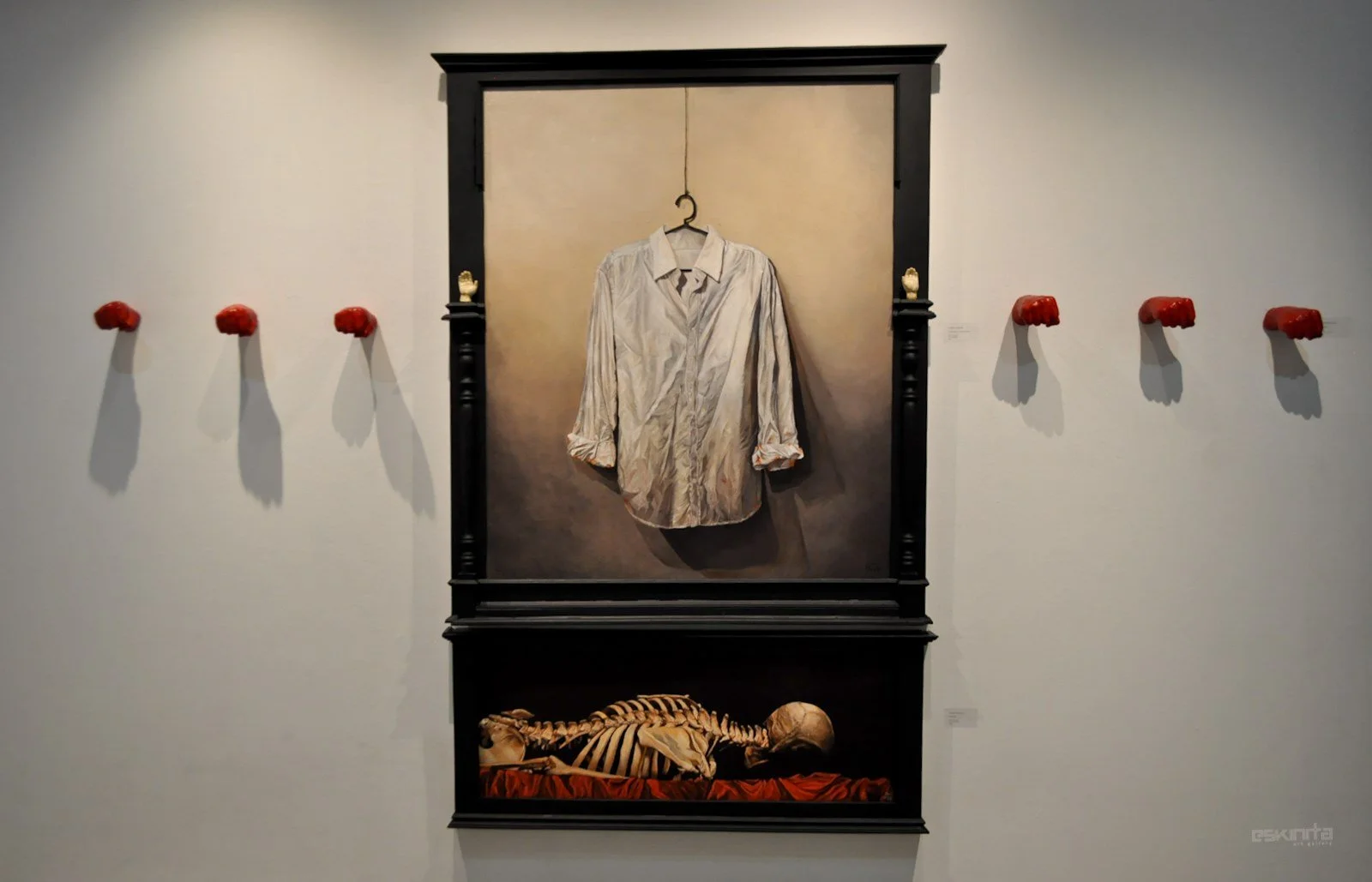

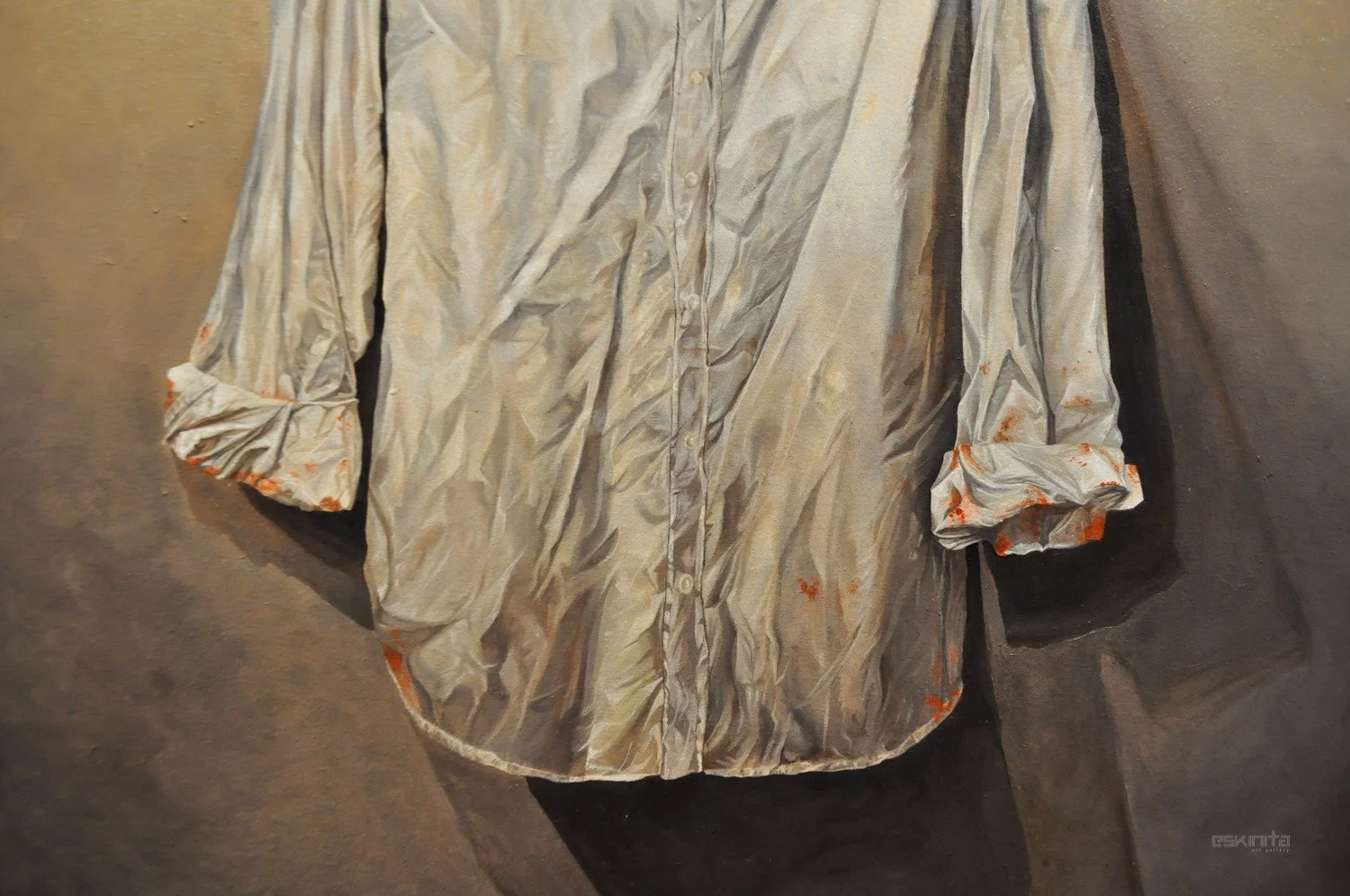

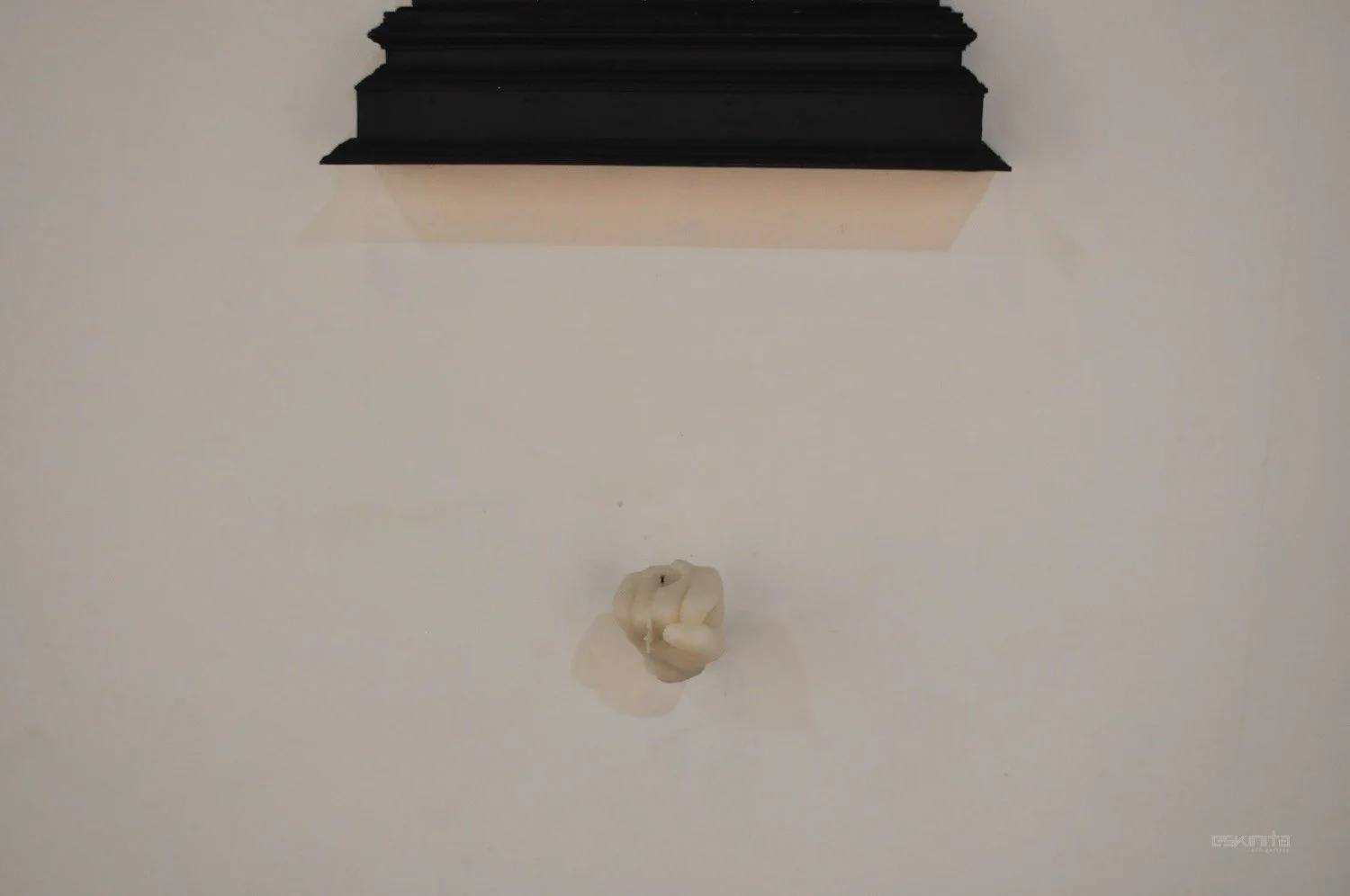



TAMER KARAM: The Price is Your Attention
In a world dominated by social media, we are conditioned to keep up with the speed with which information is rapidly disseminated and absorbed. There is so much being said and done by everyone, everywhere, all the time, and we have near-endless access to this never-ending stream of knowledge and noise. It is difficult to distinguish one from the other. We cannot help but follow along in its wake, and as a result we sometimes forget what is truly important. In the midst of this, Tamer Karam stands against the flow, and asks for our attention. He turns an unflinching eye on the sociopolitical turmoil of the Philippines, and his work will not be denied. In it, he conveys the direness and the urgency of our society’s situation, relating to, in his own words, “the drug war, vilifying human rights activists and advocates, attention span of the masses, [and] disregarding deaths of thousands of innocent and guilty lives.”
In “I’d be happy to slaughter them,” Karam takes inhuman words and reminds us that they were used to refer to actual human beings, our fellow men and women. While the killing of innocents in the war on drugs is no secret, many still believe that the right thing is being done for the sake of the greater good. But Karam acknowledges that social media and the prevalence of fake news play a role in glamorizing these ideas and concepts. In “Death Toll,” the tragedy and irony is that there is no exact number for the deaths in this unjust war. “Untitled” hands populate the instillation; red fists, white hands in the shapes of guns. Respectively, these symbolize being caught red-handed, and the issue of attention, which, like a candle, only lasts so long. “Behind You!!” is intended as both a literal and figurative mirror for the other works. It recalls a mini altar, a tabernacle frame with a mirror at its center. In it, people will see not only their own reflections, but the other works reflected behind them; works symbolizing the killer and those killed, who the viewers may have turned their backs on.
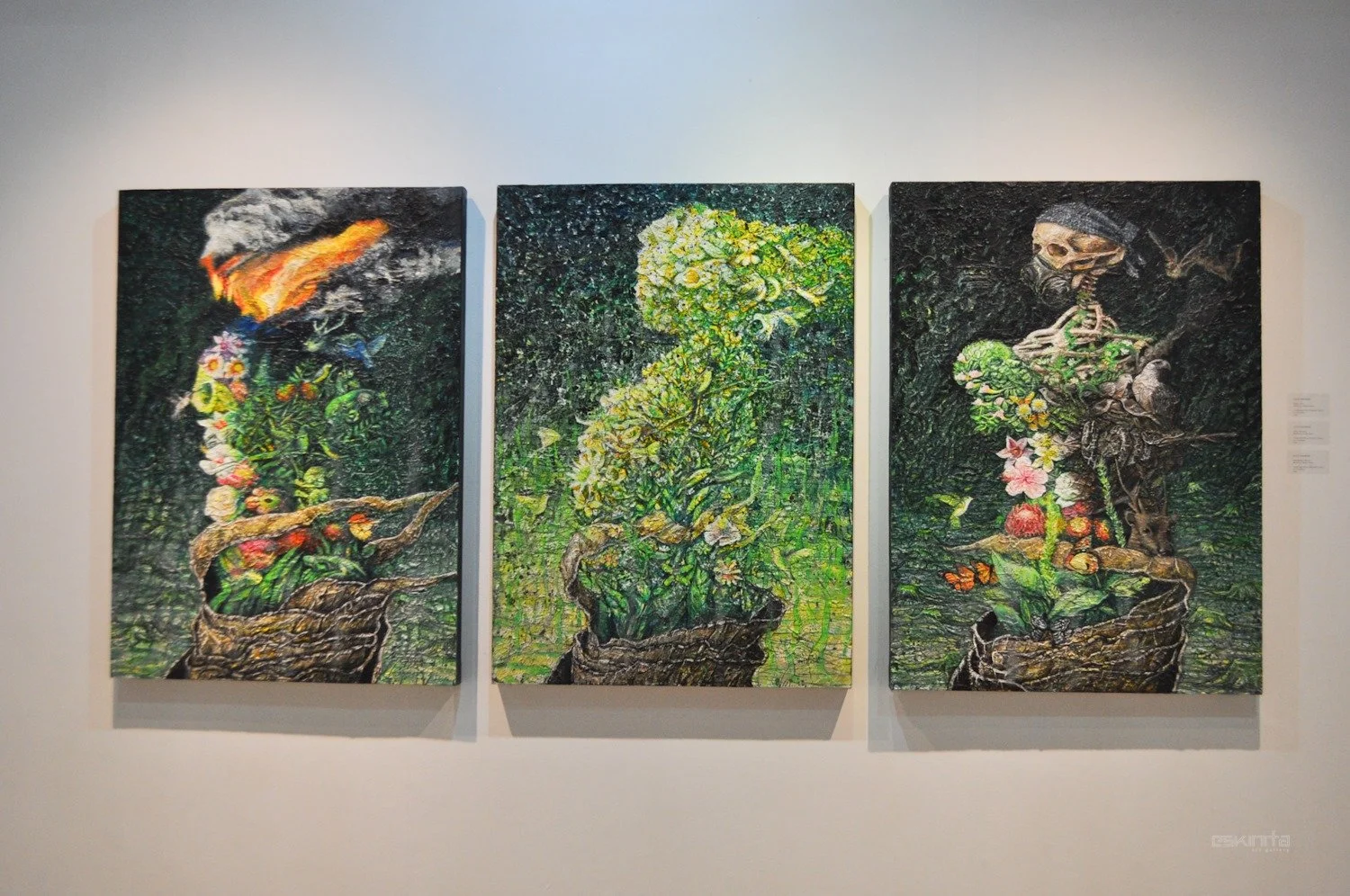
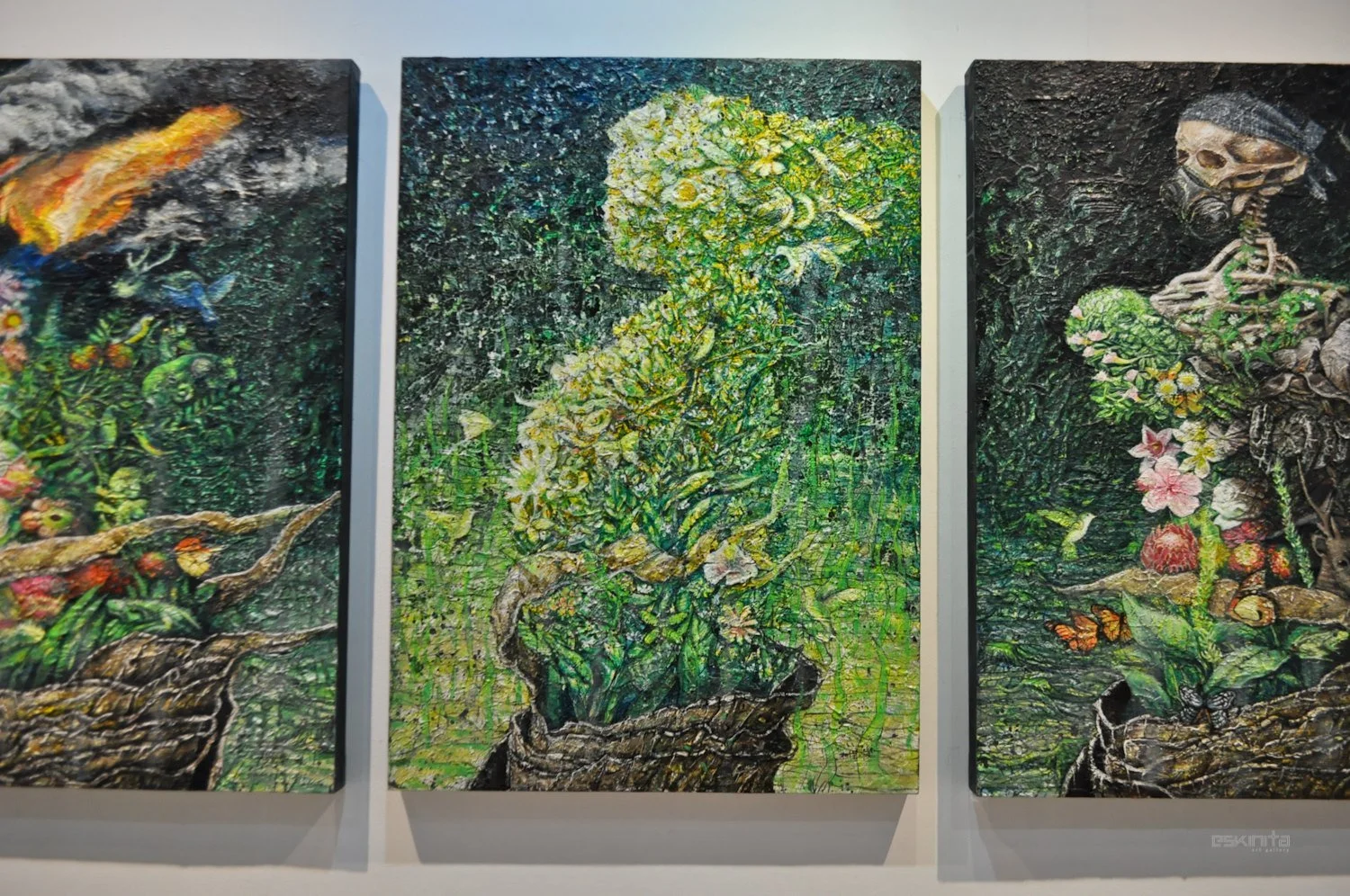


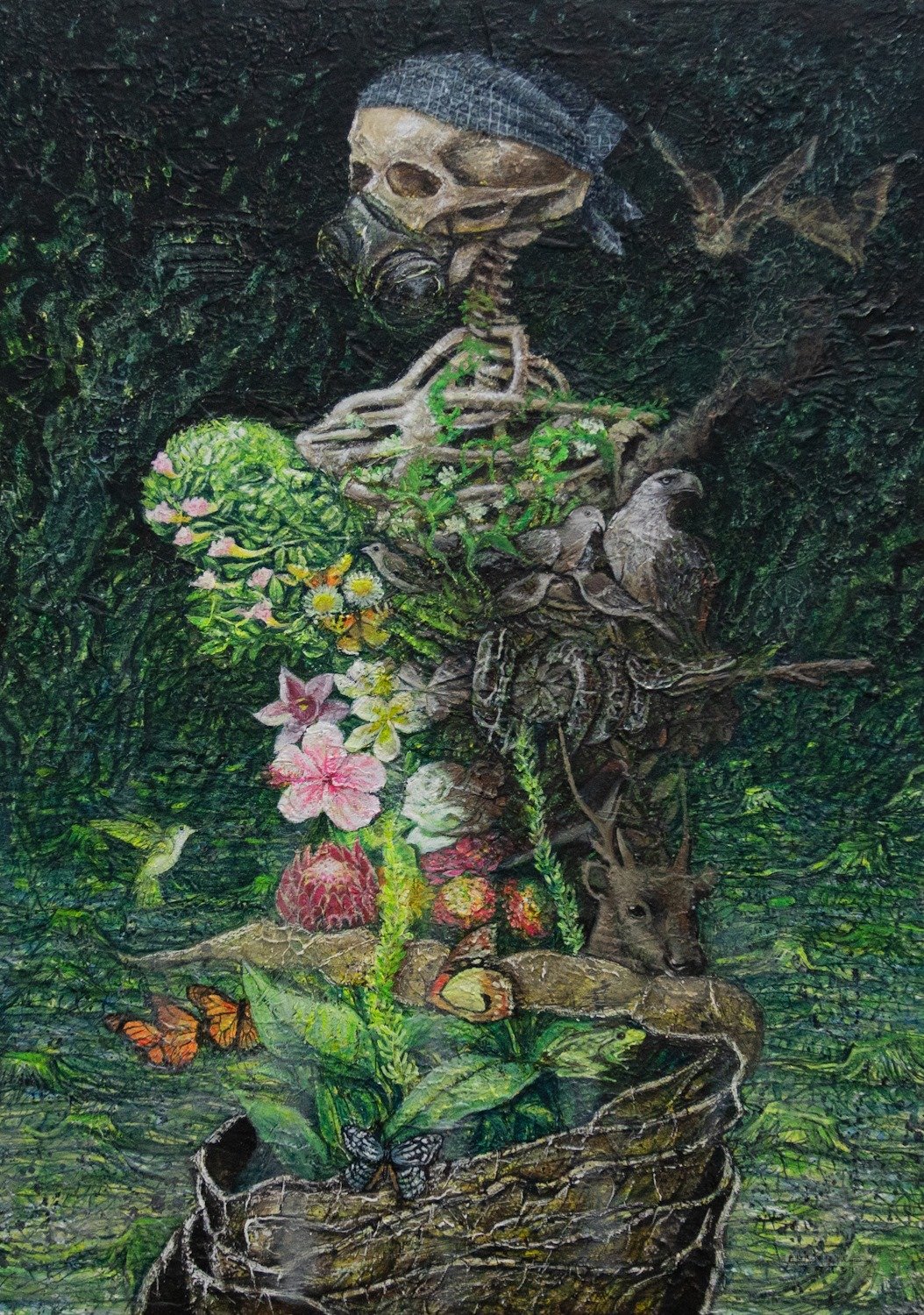

ALEX ORDOYO: Nature and Nurture
Alex Ordoyo's work is deeply attuned to the natural world. Here, the images of flora and fauna and the human body are so intrinsically woven with each other, that one must contemplate: is it nature that gives shape to the body, or vice versa?
“Boceto #1,” a study of the three-part “Bodies in Nature,” is a simple but no less impactful rendering of the same messages conveyed in the series itself. “Pamukadkad (Bloom)” was inspired by his wife’s pregnancy, and conveys the purest understanding of nature: as something that gives life and nurtures, as it in turn must be nurtured. “Abiso (Warning)” portrays an upright skeleton. And while it is interwoven with other signs of life—plants, animals, a baby in its arms—there is an undeniable ominousness to the work, communicating the creeping disturbances from human activity onto nature. In “Kalayo (Fire),” the danger has come to pass, depicting endangered species and the destruction that looms over it all.
The works follow a natural progression from creation to destruction, made all the more powerful amidst our current global ecological crisis. Ordoyo gives these concerns human form, in order that we might more deeply empathize with and internalize them. Here can be found great love and empathy for the environment, a celebration and a reminder of the inherent connection we share with the world around us, and each other.








ORLAND: In Perpetuity
Orland communicates life and death through the different figures and sculptural techniques he has come to master. In “Here,” he attempts to put forward the reality of freewill – to choose between sins or virtue, and its consequences in life and beyond.
“Hereafter” then, is the artist’s portrayal of the after death, particularly as a consequences of one’s flawed choices and decisions resulting to an even worse dissolution. The ruinous form of the piece exhibits that harrowing emotion of pain, suffering, and a mournful soul.
And finally, “Do You Want it For Life, or Forever?” is the artist’s skillful and painful representation of sorrow, war, and calamity. These are the distressing events people experience in the profane world. Here the artist offers a line of questioning to its audiences: in this life where suffering is real always present do you want to suffer for life or forever?

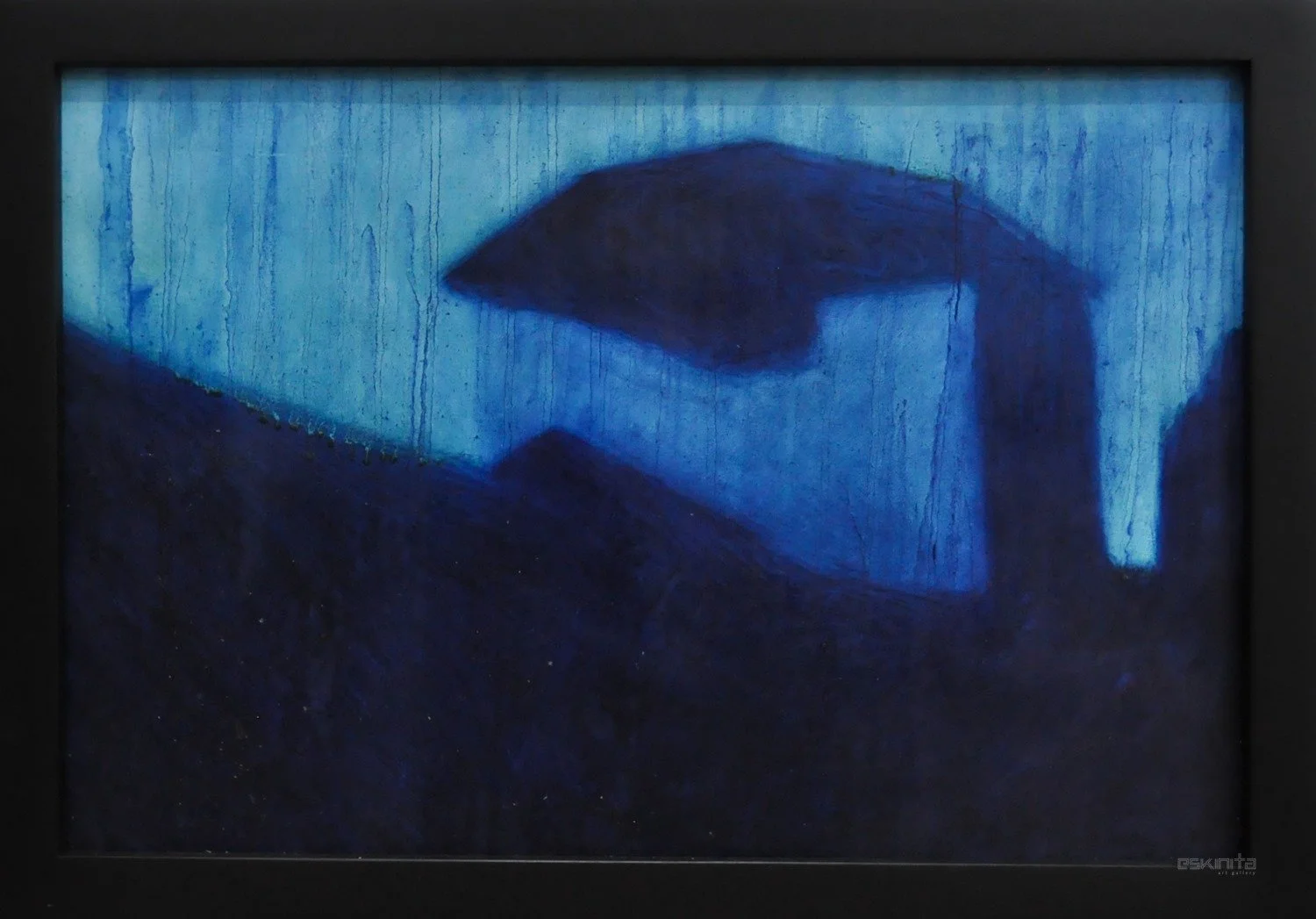


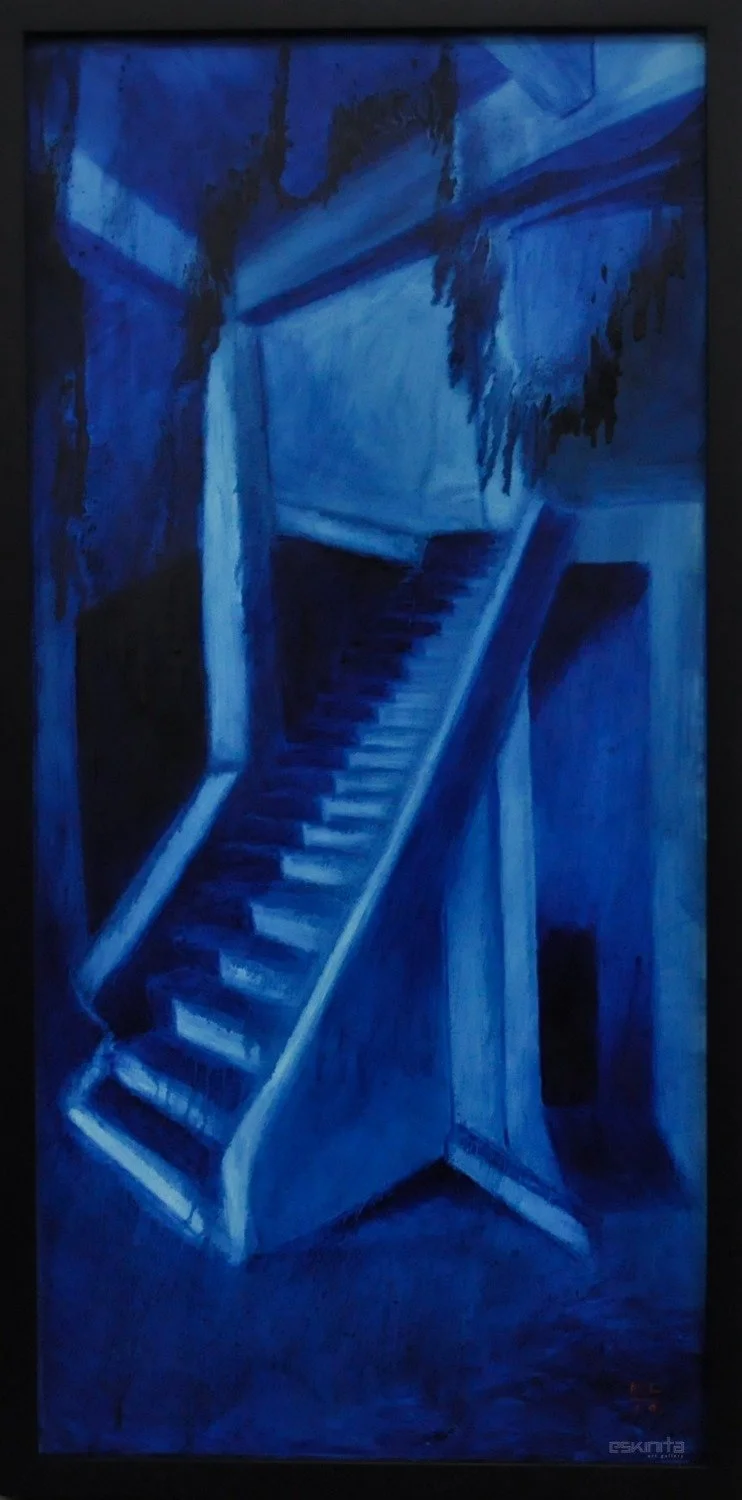
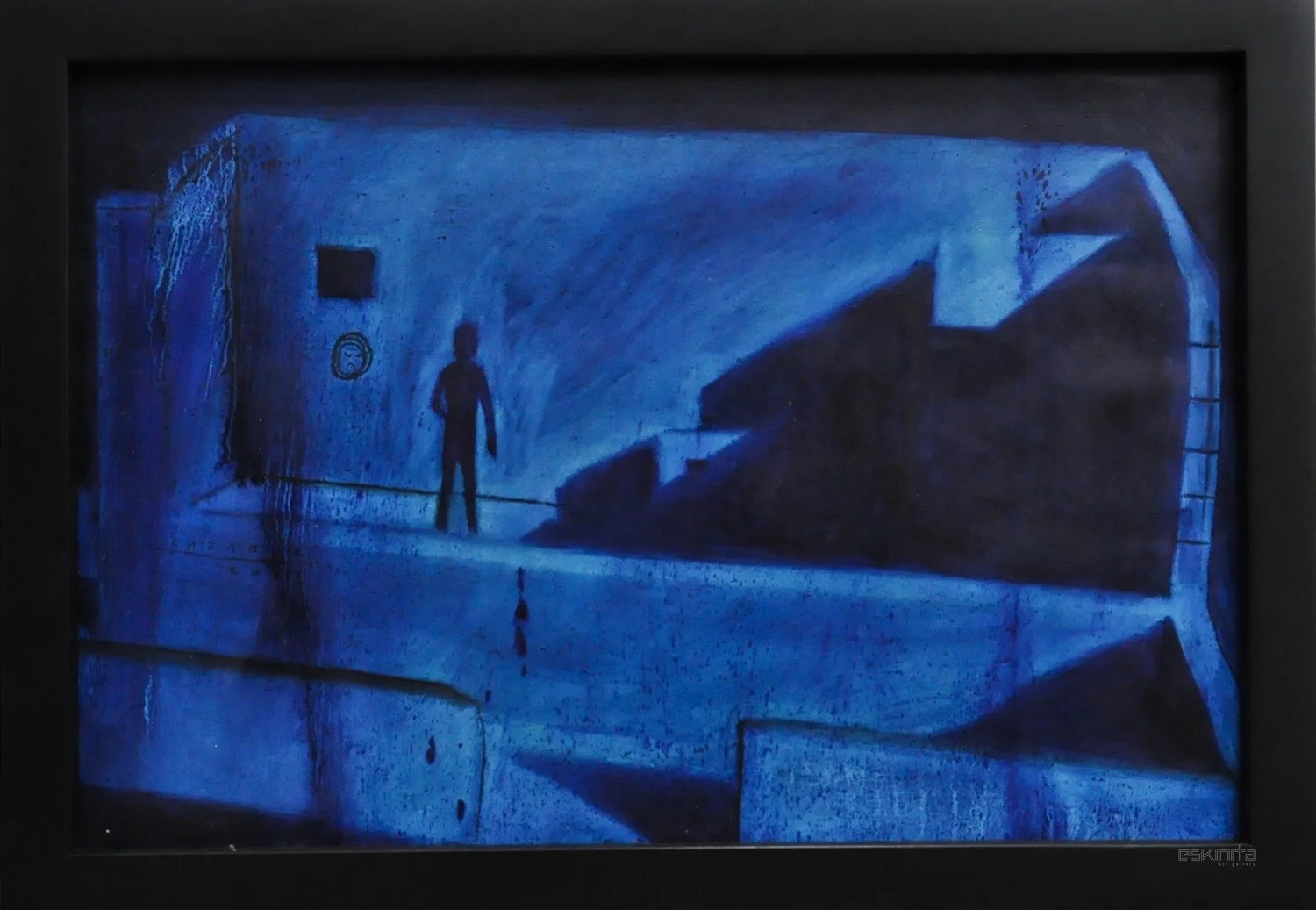
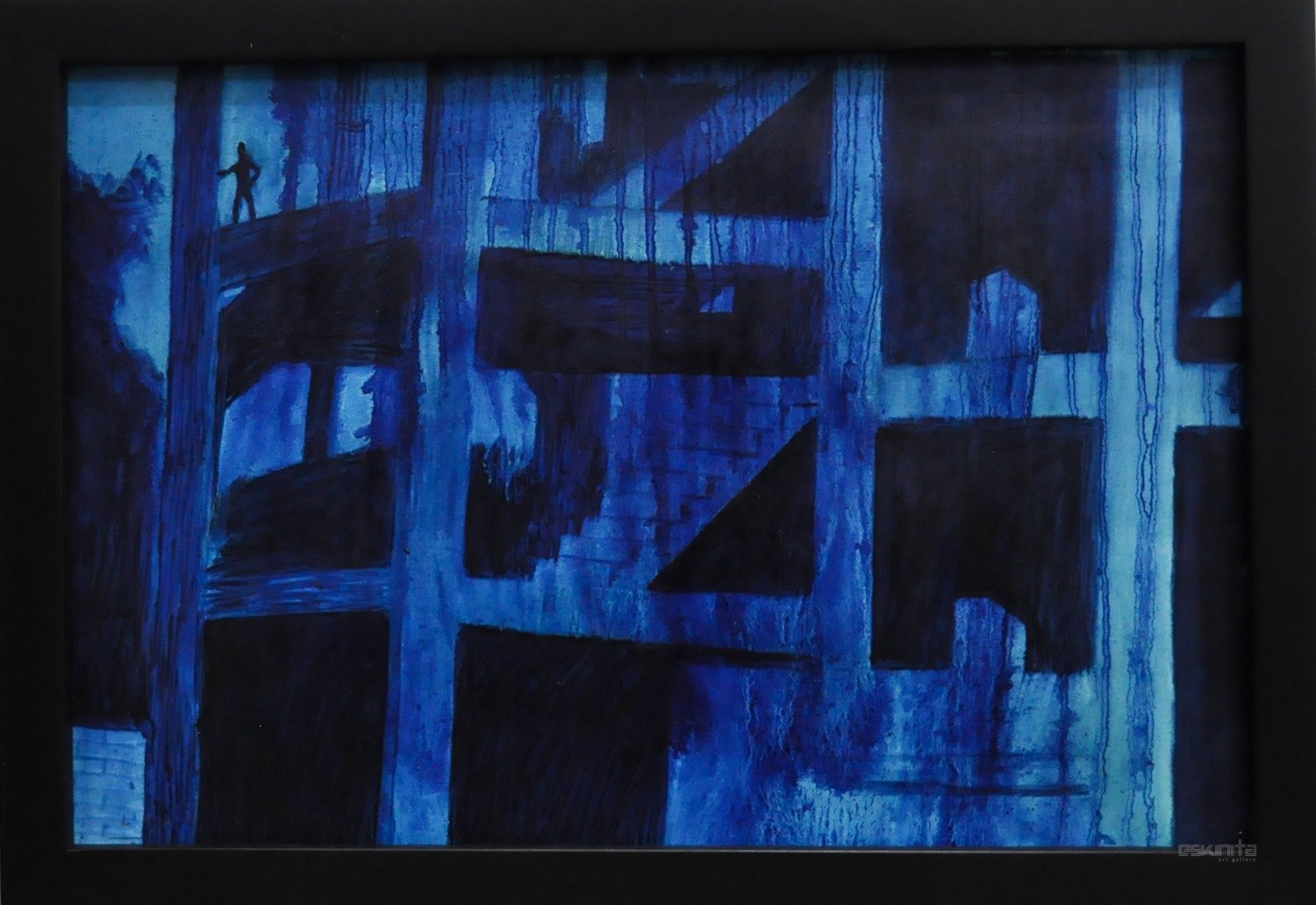

MCCOY LAZARUZ: Blue Period
Abandoned structures and indistinct figures dominate the works of McCoy Lazaruz. He proposes this: places can haunt, as well as be haunted. Simultaneously, he challenges our perception of hauntings as phenomena that can only be grounded in the physical. In these works, the site of this haunting is the mind.
All the places depicted here are from Lazaruz’s childhood, reminders of places he used to go, that were integral to his upbringing, that he remembers with fondness. The “Sikret Base” series is somewhere he frequented with friends. The apartment rooftop in “Untitled” can be seen from his local basketball court, and is a place he’s always wanted to enter but simply never has. “Bukas na Silong” is a structure near his home that has been unfinished since childhood, but has nevertheless gained a life of its own somehow, and even has people living there. “Dinilaan ng Apoy” shows what was once a store that sold fireworks and the like before it was burnt down, and now only its ruins still stand.
The varying shades of blue with which he builds these places, these memories, create an undeniably eerie effect. While to Lazaruz these places may conjure nostalgia, to a stranger they may be as unnerving as they are compelling. This speaks to a knowledge deep within us all: everything that surrounds us, all the things we hold dear, will one day be gone from us.
Lazaruz acknowledges this reality, and doesn’t turn away from it. While all the places he depicts here are still standing, he knows that this may not always be the case. He wishes to preserve them somehow, so he can still see them when they’re gone, and always return to them. One day, they will only exist in memory.


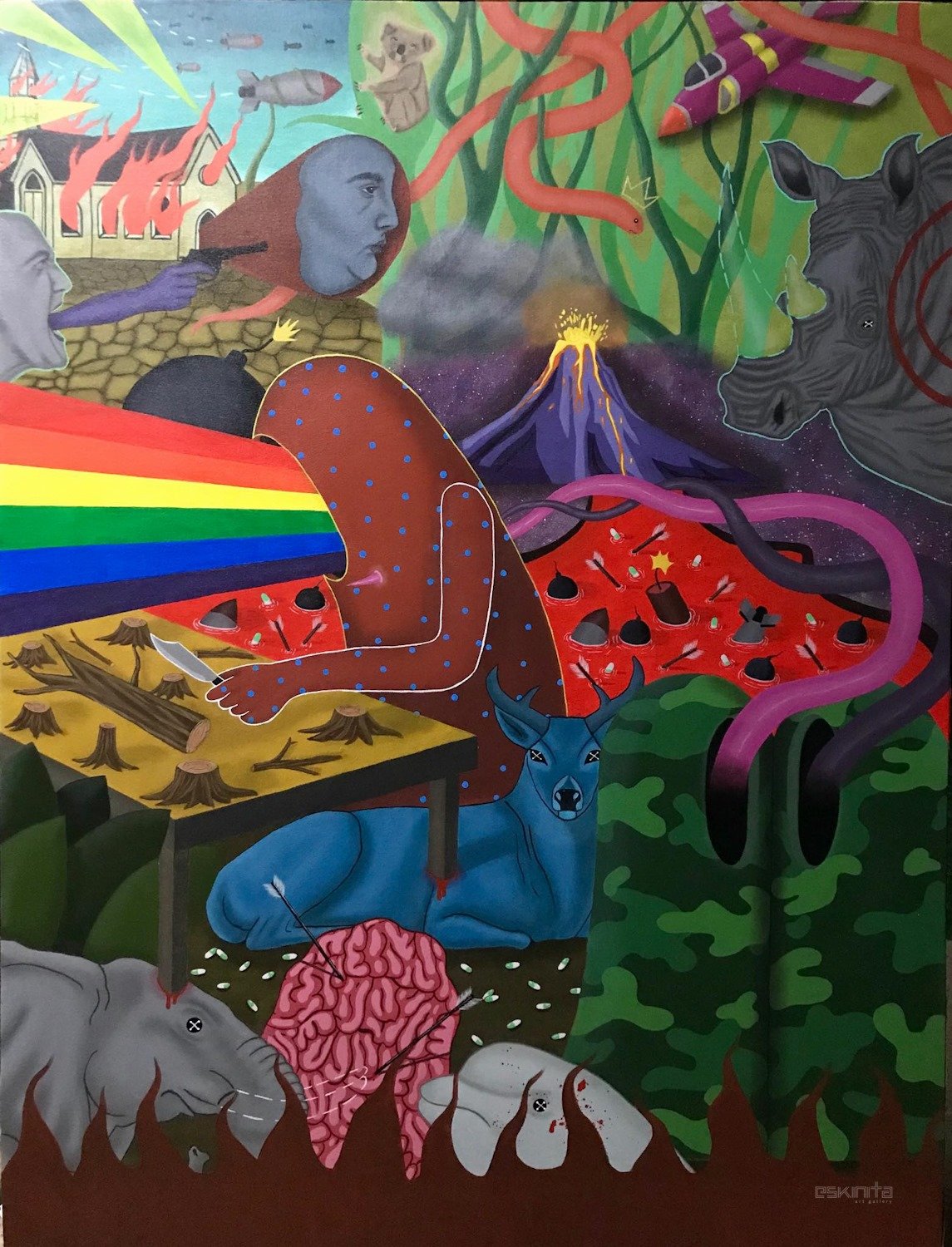




RACHEL ANNE LACABA: The Usual Grind
Equipped with a series of magical symbolisms, Anne Lacaba Rachel’s works show sensibilities for the environment and the negligence of mankind that causes its gradual destruction.
Human being’s limitless desire to create, develop, and conquer, is the main drive for this very spoliation. As if mindlessly, mankind does this in a recurring manner. And in the end the truth remains. The more humans deprive the environment of its life, the more they are actually destroying their own – for codependence whether destructive or constructive, is the natural course of life.



LYMUEL BAUTISTA: A Requiem for Empathy
Lymuel Aguilar Bautista speaks through his works with a series of enquiries as in a crime scene. In both of them, a casket serves as the critical point of inquest on what happens when one is put to rest. Did it happen on a whim? Was it a murder? Who are the suspects?
The principal tension is bestowed upon the characters surrounding the casket. These people present themselves as mournful, but apathetic, pretentious, and even jovial in disposition. Looking closely, we’ll see that some characters are dressed in clothing that symbolizes they are of high importance in the society, or perhaps even a public servant. The closest character to the casket is in fiery and monstrous depiction, as if this situation is bad and is getting worse in itself. With the victim’s eyes’ blindfolded, the artist portrays injustice for the crime committed, and the guests’ presence as a mere spectacle to further mask and strengthen their monstrous crimes, desires and aspirations.
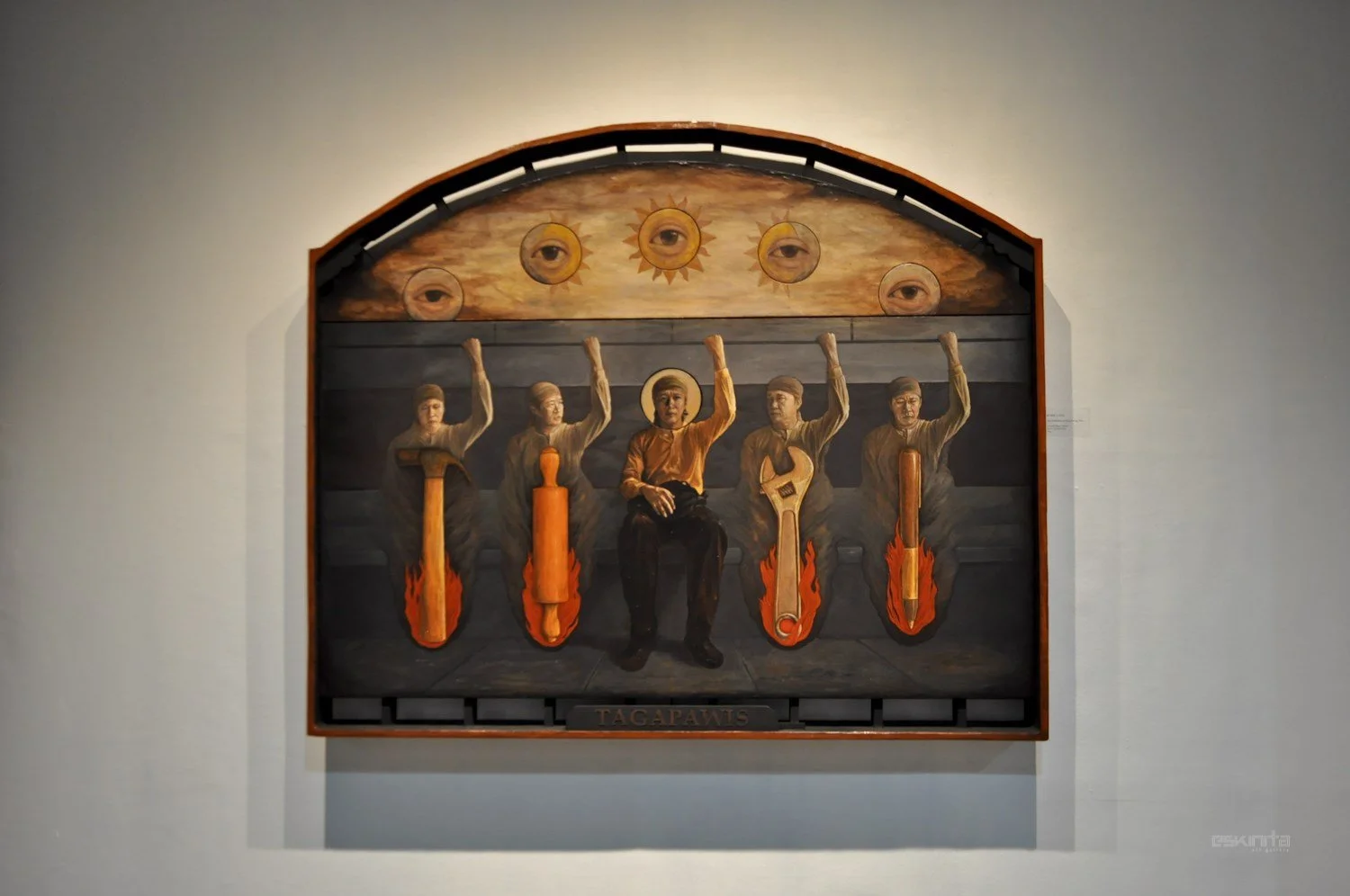







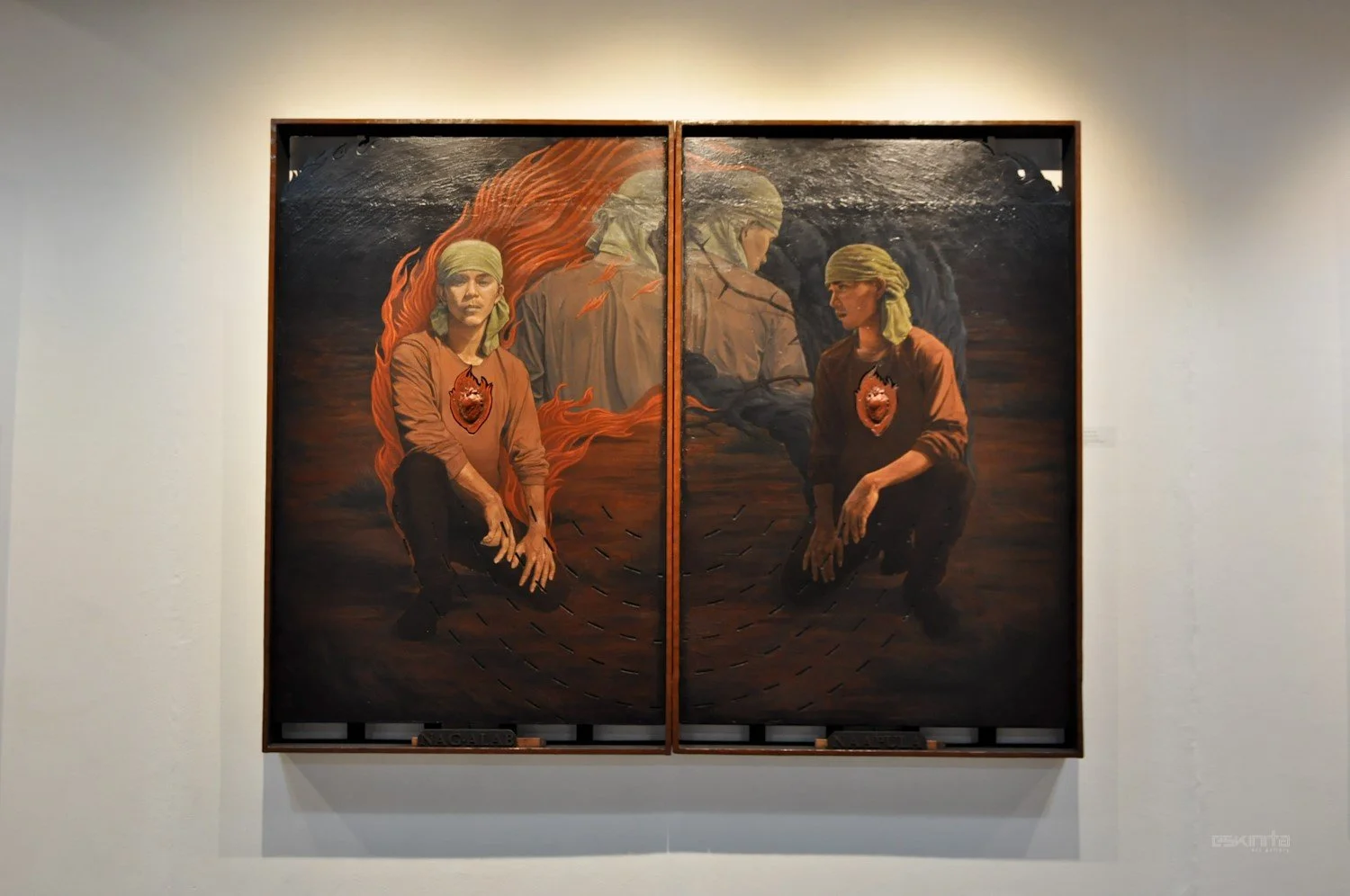
MARK LAZA: Continuance in Privation
Mark Laza delves on the lives of common people, the strength gained from their hardships, and their drive for reason. In a work called “Ang Tagapawis, sa Ikatlong Anyo,” he portrays an image of a person, particularly a laborer, with three forms. The first configuration shows the person’s strength despite hardships, and despite injuries. The second displays zealousness, as if that of a carabao. And the third shows a Messianic image, that in open arms, sacrifices, loves, and endures. All of these, that one person goes through to bring forth the needs of the family, and to foster a home suitable for living. “Mga Katauhan ng Isang Buong Araw” further probes on the truth of adversity for the poor. One whole day, and one distinct profession is not enough for one person to sustain the needs of an entire household. And so, for the subject, one day requires him to endure hard work in the morning, change character until the sun goes down, or until a new day comes in.
Describing one’s contemplation in life is put forward in the work “Pinagmulang Tatag.” One’s life consists of a series of ups and downs – events that ignites or douse one’s desire to be human. The piece shows that in times of toil and trials, one goes back to that which gives him life. As represented by the driving red color conferred upon the soil, this very reason endows endurance, strength, and persistence.


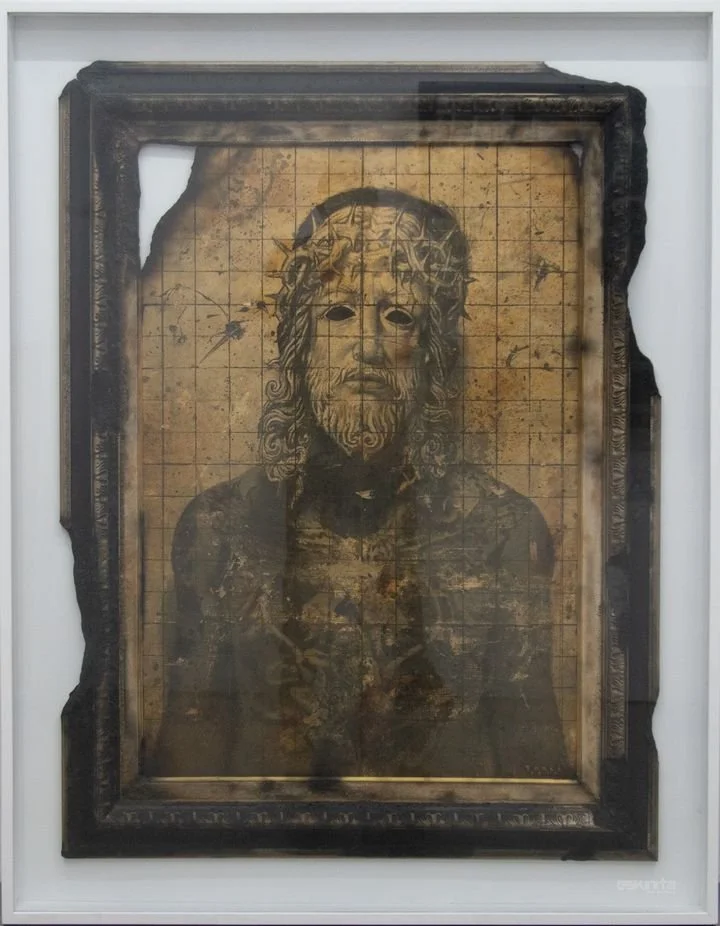
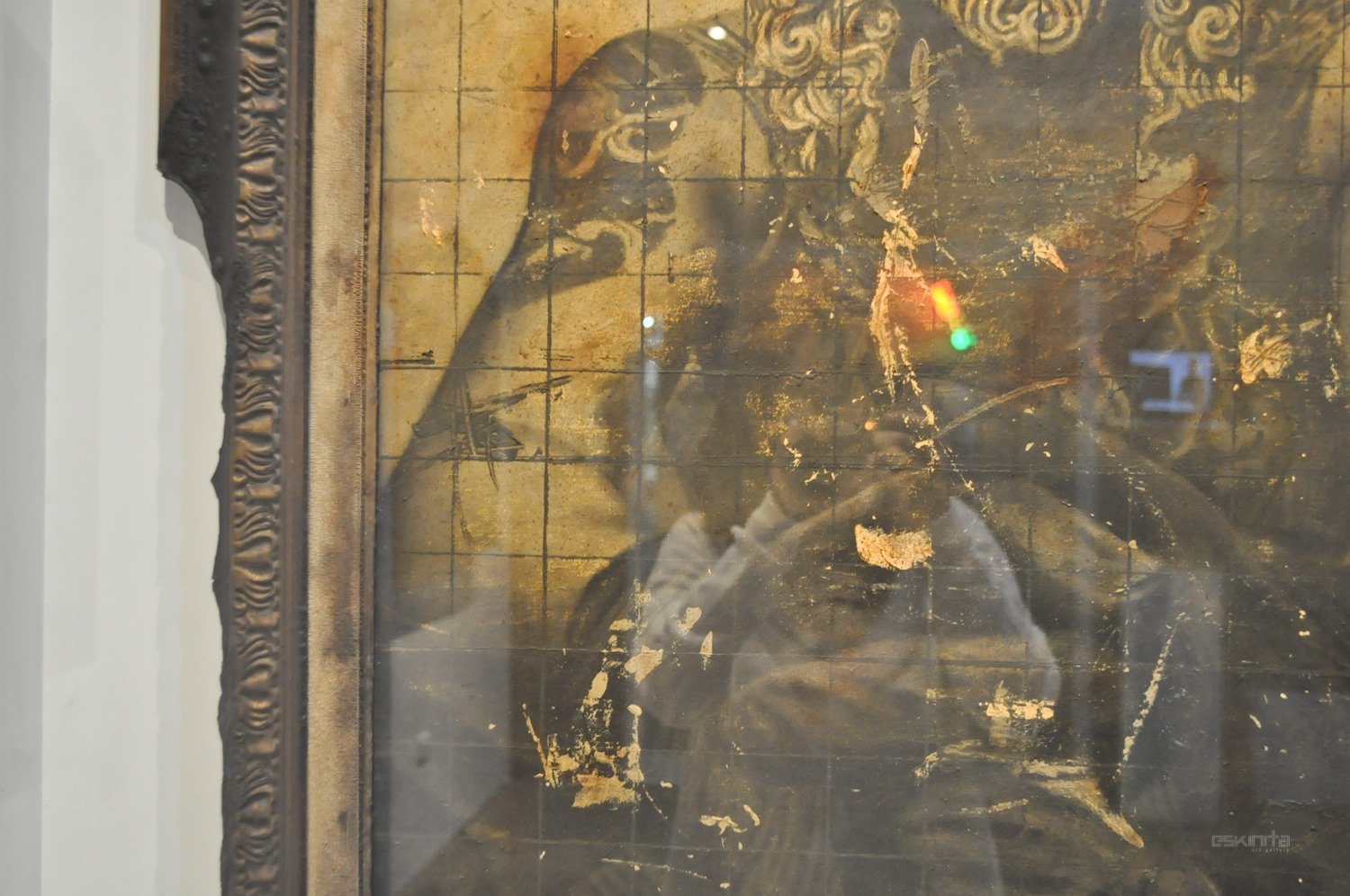
MACJ TURLA: Things Lost and Made in the Fire
On January 1, 2016, Macj Turla’s home in Tondo, Manila caught on fire. This was a catalyst for material and personal struggles, ones that Turla has gone on to overcome, and to transform into a new mode of expression.
This incident inspired him to pursue his current technique, which involves burning his works, ultimately achieving a sepia-toned, vintage appearance. He chose to take his losses and remake them into pieces revolving around memories, oftentimes his own memories of his life in Tondo. He draws from the happiness and hardships, and the strength that arises from both.
“Sa Isip, sa Salita, at sa Gawa I and II” depict people who conceal their true selves. They wear masks of the Passion of Christ, projecting purity, but only to hide the darkness within themselves. Turla describes them as hypocrites. Behind the masks, their eyes are turned towards those they would harm, and they otherwise seek only to protect themselves.
Turla has taken fire and repurposed it; an element of destruction now transformed into a tool for creation. In this way, what he has lost continues to live on.
-Helena Baraquel

